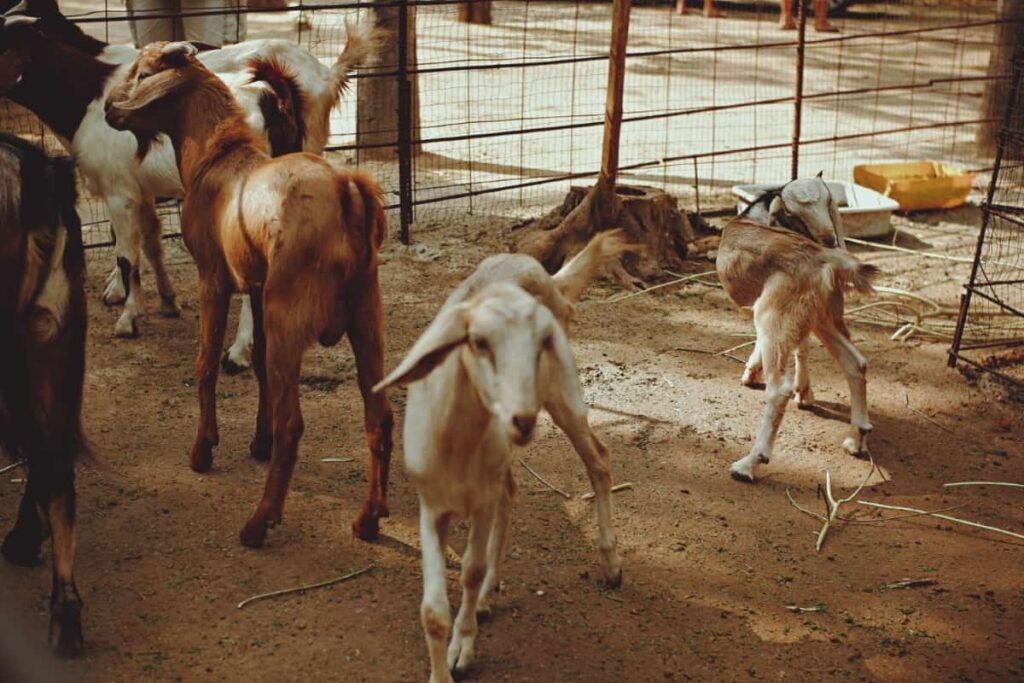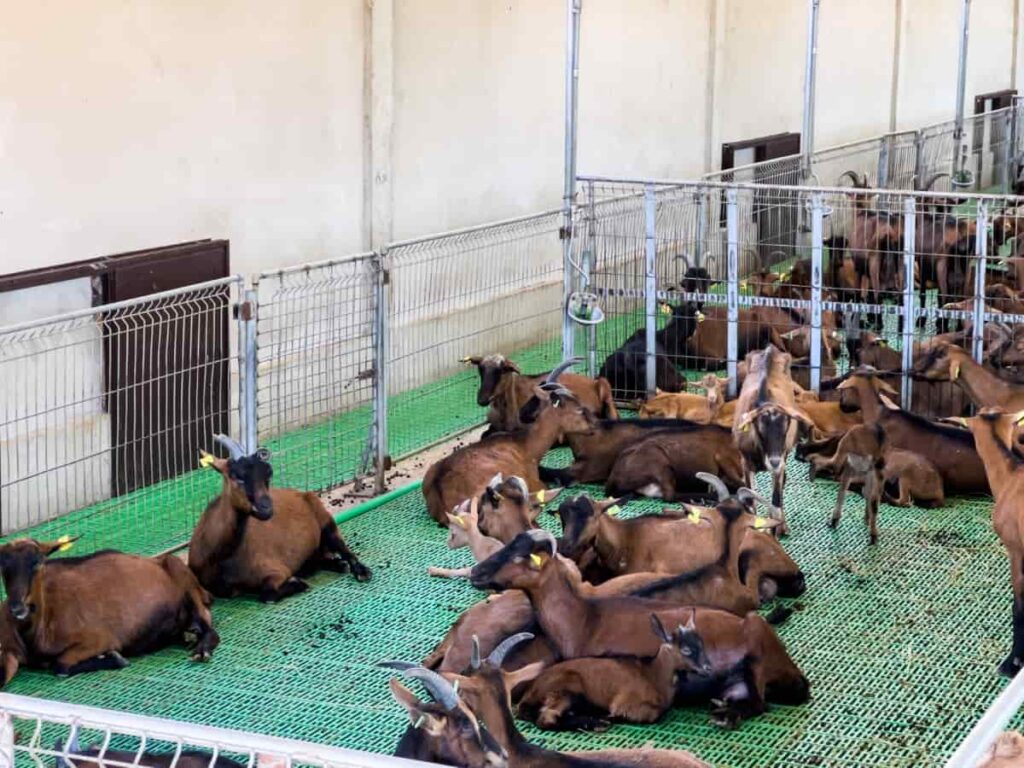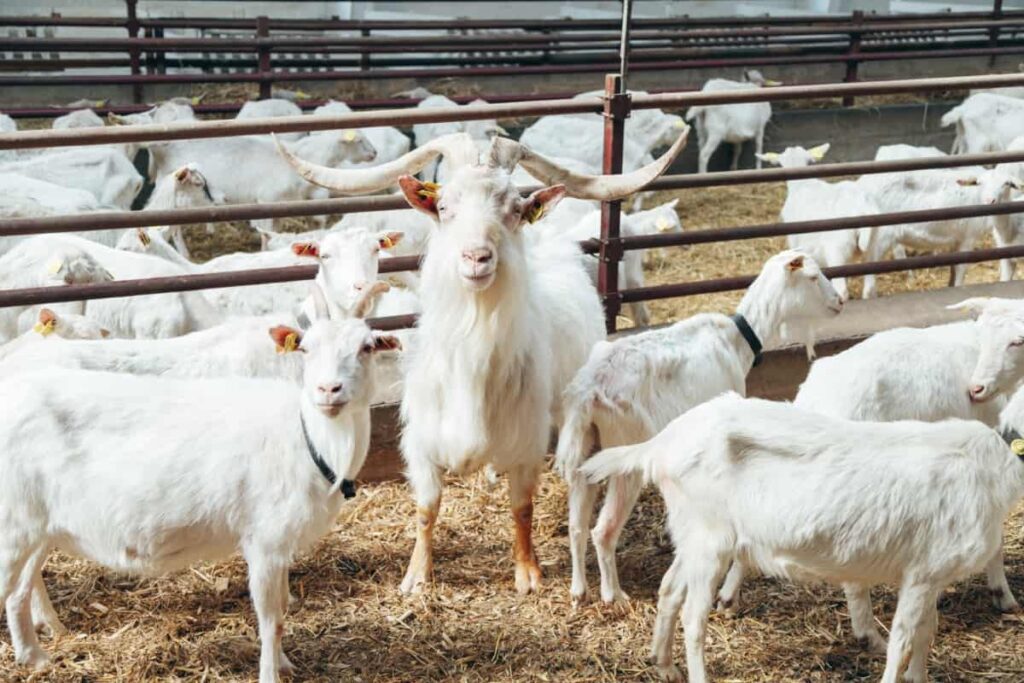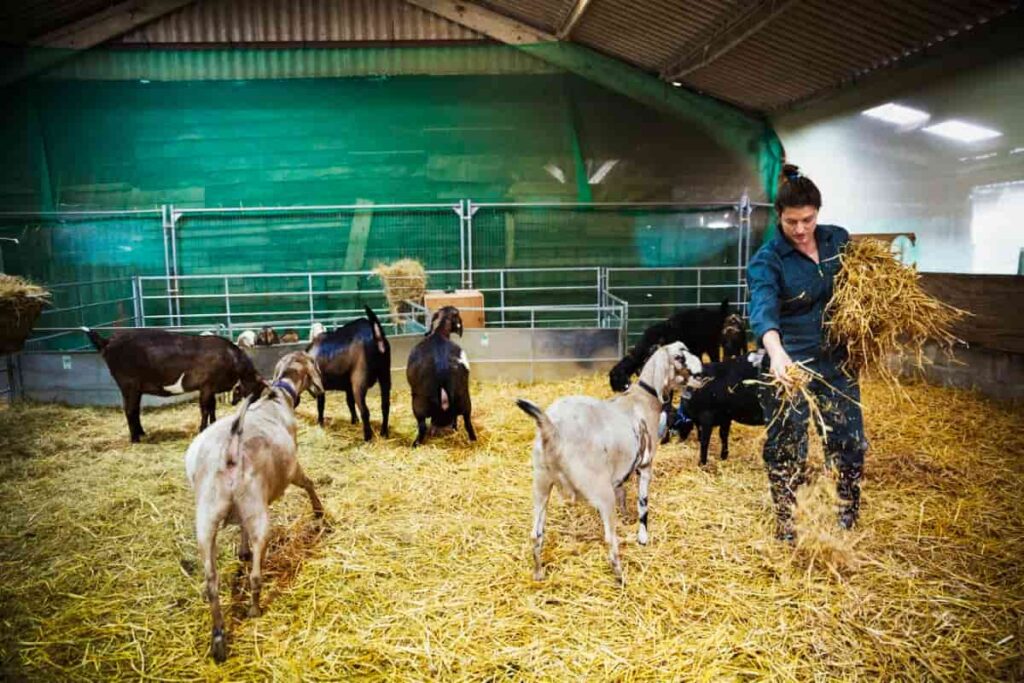Integrating goats into sustainable farming systems is an innovative approach to agriculture that combines the benefits of raising goats with environmentally friendly practices. It involves incorporating goats into a holistic farm management system that focuses on sustainability, biodiversity, and natural resource conservation. In this system, goats are not just seen as livestock for meat or milk production but also as valuable contributors to the overall health and productivity of the farm ecosystem.

Goats into Sustainable Farming Systems
Benefits of Using Goats in Sustainable Farming
The benefit of integrating goats is their ability to control weeds and invasive plant species. Goats are natural browsers, meaning they preferentially eat shrubs, trees, and other woody vegetation over grasses. This makes them excellent at clearing land or maintaining pasture areas without relying on harmful herbicides or heavy machinery.
Another benefit is that goats are relatively easy to care for compared to other livestock animals. This makes them suitable for small-scale farmers or those with limited resources. The integration of goats also brings economic opportunities for farmers. These additional revenue streams can contribute significantly to the financial sustainability of farms.
Selecting the Right Goat Breeds
Consider your specific goals and needs for your farm. Another factor to consider is the climate and environment in which your farm is located. Each breed of goat has its unique characteristics and strengths that make them well-suited for different purposes. For example, if you’re interested in milk production, Nigerian Dwarf or Saanen goats might be the perfect fit. These breeds are known for their high milk yields and sweet, creamy milk.
On the other hand, if meat is what you’re after, Boer or Kiko goats could be a great choice. If weed control is a priority on your farm, then Alpine or LaMancha goats might be worth considering. These breeds are known for their voracious appetites and ability to graze on vegetation.
Housing and Infrastructure for Goats
Providing suitable shelter for goats is essential to protect them from predators and diseases. A simple but effective option is a sturdy, well-ventilated barn or shed that offers protection from rain, wind, and excessive heat. It should have proper drainage to prevent moisture buildup that can lead to health issues.
In case you missed it: Mineral Supplementation in Goat Diets: Meeting Nutritional Requirements

Provide clean bedding, such as straw or wood shavings, for comfort and hygiene. In addition to housing, goats also require secure fencing to keep them contained within designated areas while allowing access to fresh grazing land. Water availability is another critical aspect of goat housing.
Feeding and Nutrition Management for Goats
It’s important to provide a balanced diet that meets their nutritional requirements. Goats are herbivores, so their diet should consist mainly of forage such as pasture grasses, legumes, and browse plants. It’s essential to ensure access to fresh water at all times. In addition to forage, supplemental feed may be necessary depending on the nutritional needs of goats.
Feeding practices should be tailored based on the age and stage of production of the goats. Adjustments in feeding may be needed accordingly. Grazing rotation can help optimize forage utilization while preventing overgrazing in certain areas. A well-managed pasture system will provide ample grazing opportunities throughout the year.
Health and Disease Management
Maintaining the health of your goats is crucial for their overall well-being and productivity. Implementing effective disease management practices in goats can help prevent the spread of illnesses. Vaccinations against common diseases such as tetanus, pneumonia, and clostridium perfringens should be administered as recommended by a veterinarian. Maintaining a clean environment is also important.
Regularly clean out bedding areas and remove any feces or soiled materials promptly to reduce the risk of contamination. If you notice symptoms, consult with a veterinarian immediately to diagnose and treat any potential issues early on. Implement good biosecurity practices to limit contact between your goats and outside animals that may carry diseases. This includes limiting visitors’ access to goat areas or needing them to wear protective clothing when entering these spaces.
Grazing and Pasture Management
Properly managing grazing areas not only ensures that the goats have access to nutritious forage but it also helps prevent overgrazing and soil erosion. To effectively manage grazing, farmers should practice rotational grazing. This involves dividing the pasture into smaller sections and rotating the goats between them.
In addition to rotational grazing, farmers should also consider implementing strip or paddock grazing. Strip grazing allows for better control over where the goats graze and promotes more efficient use of available forage. Proper monitoring is essential when it comes to pasture management. Furthermore, incorporating multi-species grazing can be beneficial in sustainable farming systems.
Reproduction and Breeding Strategies for Goats
Selecting the right breeding stock is essential for ensuring healthy offspring and improving overall herd genetics. Determining the optimal breeding age for your does is important. Generally, they should be at least 8 months old before being bred, but this can vary depending on the breed and individual health. Another aspect to consider is choosing appropriate mating methods. Natural mating is commonly used in goat farming, where bucks are allowed access to does during their heat cycles.
In case you missed it: Utilizing Goats for Weed Control in Pastures and Woodlands

However, artificial insemination can also be considered as an alternative method. Monitoring doe heat cycles is vital for successful reproduction. Proper nutrition during pregnancy is crucial for the health of both the mother and her offspring. Breeding strategies should focus on improving desirable traits in your goat herd while minimizing genetic defects or weaknesses. This involves keeping detailed records of each goat’s characteristics and performance over time.
Integrating Goats with Other Livestock
Integrating goats with other livestock can also provide economic benefits through complementary grazing strategies. By rotating pastures between different animal species, farmers can optimize land productivity while minimizing input costs. One popular option for integration is combining goats with sheep. Both species have similar dietary needs and graze on different grasses, which helps maximize pasture utilization.
Poultry is another type of livestock that can be integrated successfully with goats. Cattle are also compatible with goats in some cases. Goats can help keep pastures clear of weeds and brush that cattle may not prefer to eat. However, caution must be exercised when introducing these two species together due to potential competition for resources like food and water.
Integrating pigs or rabbits alongside your goat herd can also bring added advantages. Pigs excel at rooting up plants and clearing land, which complements the grazing habits of goats perfectly. Meanwhile, rabbits benefit from sharing pasture space as they feed on different vegetation than their goat counterparts.
Economic Considerations of Integrating Goats
Goats can be an excellent income source through various avenues. Goats can be a profitable addition to your farm as they have multiple income streams. Goat milk can be used for dairy products, which can be sold directly or turned into value-added products. Furthermore, raising goats requires relatively less investment compared to other livestock, such as cattle or horses.
The market demand for goat products has been increasing over the years due to rising interest in healthier and more sustainable food options. This growing consumer trend provides farmers who integrate goats with a promising opportunity to meet this demand while generating profit.
Frequently Asked Questions (FAQ) on Integrating Goats Into Sustainable Farming
Can Goats Help with Weed Control on the Farm?
Yes. Goats are fantastic natural weed controllers. Their grazing habits often target unwanted weeds, helping to keep them in check without relying on harmful herbicides or excessive mechanical methods.
How Can Integrating Goats Contribute to Sustainable Farming Practices?
Goats’ grazing behavior allows them to utilize marginal lands that may not be suitable for traditional agriculture or grazing by larger livestock species. By utilizing these resources effectively without causing environmental degradation, goat integration promotes sustainable land management practices.
How Do I Manage Parasite Control in a Sustainable Way when Raising Goats?
Implementing a holistic approach is key when it comes to parasite control in sustainable goat farming systems. Practices like rotational grazing, strategic deworming using herbal remedies alongside modern medications, and maintaining clean living conditions all contribute towards minimizing parasite burdens naturally.
In case you missed it: Steps to Start Goat Farming in Nagaland: Housing, Health Care, and Marketing

Conclusion
Goats have long been admired for their ability to adapt to various environments, making them a valuable addition to sustainable farming systems. Integrating goats into sustainable farming systems is of utmost importance for several reasons. They are excellent grazers and can help manage vegetation by consuming weeds, shrubs, and even invasive plant species. This not only reduces the need for chemical herbicides but also promotes biodiversity by allowing native plants to thrive.
- Types of Grass Growing for Goat Farm
- How to Train Goats for Milking: A Beginners Guide
- Goat Milking Practices and Equipment: A Beginner’s Guide
- Goat Farming for Fiber: Producing Mohair and Cashmere
- Maximizing Goat Milk Production: Tips for Dairy Goat Farmers
- Goat Farming as a Family Business: Strategies for Success
- Profitable Kenya Goat Breeds for Commercial Dairy and Meat Business
- Unlock the Secrets of Oberhasli Goat: Discover Raising and Management Practices
- Ultimate Guide to Myotonic Goats: Explore Profile to Raising